5 minutes
August 26, 2025
Healing healthcare operations: Bridging the gap between facilities and finance
In hospitals, the divide between finance and facilities teams isn’t just a structural issue, it’s a risk multiplier. Both groups are charged with protecting the long-term health of the organization. Yet they often operate with fragmented tools, mismatched metrics, and conflicting timelines. The result? Missed opportunities, preventable costs, and operational blind spots that can ultimately impact patient care.
To create sustainable, high-performance hospital environments, leaders must build a stronger bridge between facilities and finance, a bridge supported by shared data, common goals, and systems that unify instead of divide.
To create sustainable, high-performance hospital environments, leaders must build a stronger bridge between facilities and finance, a bridge supported by shared data, common goals, and systems that unify instead of divide.
Two sides of the same coin: Finance and facilities
At a glance, the finance and facilities functions seem worlds apart:
Finance teams are driven by cost control, forecasting, budget reconciliation, and risk management. Their tools are ERP systems, GL codes, spreadsheets, and audit trails. Their cadence is monthly, quarterly, annually.
Facilities teams are focused on uptime, maintenance, compliance, and occupant safety. Their tools include building automation systems, work order platforms, and often, tribal knowledge. Their cadence is real-time.
Yet both groups are working toward a common goal: ensuring resilient, cost-effective, and safe environments for patient care.
The challenge? These teams often speak different operational languages and lack a shared system of record to guide decision-making. When a building inefficiency goes undetected, or a billing anomaly goes unchallenged, both sides lose.
The cost of operating in silos
The consequences of misalignment aren’t abstract. They show up in specific, measurable ways.
Energy performance is a major example. Nationally, hospital Energy Use Intensity (EUI) sits around 234 kBtu/sf2/year, while top performers bring that down into the 150s, a 30–40% delta ripe for optimization¹. More broadly, the U.S. Department of Energy estimates that 30% of commercial building energy is wasted, representing $142 billion every year in potential savings². For organizations already facing shrinking margins, every dollar of waste represents both a missed opportunity and an avoidable risk.
When finance and facilities operate in silos, those dollars slip through the cracks in multiple ways:
- Delayed insights: Utility bills are reviewed weeks or months after the cost is incurred, leaving facilities teams unable to respond proactively.
- Undetected anomalies: Equipment inefficiencies, leaks, or spikes in usage may go unnoticed until they impact comfort, compliance, or budget.
- Inefficient capital planning: Without operational data, finance teams struggle to prioritize infrastructure investments or validate ROI.
- Reputational and regulatory risk: A preventable outage or environmental issue can lead to failed inspections, service disruption, or worse, negative patient outcomes.
For hospitals where patient safety, regulatory compliance, and public trust are paramount, these risks are not acceptable.
Building the bridge: From fragmentation to collaboration
Hospitals need more than data access. They need a shared framework for using it.
Using a solution like EnergyCAP enables teams to bridge this divide by creating a centralized, validated, and role-aware view of utility data. This shared view serves as a foundation for smarter decisions across departments.
Here’s what that looks like in practice:
- Facilities teams gain real-time visibility into utility performance, energy consumption, and anomalies across the portfolio. This allows them to prioritize repairs, respond to inefficiencies, and track performance over time.
- Finance teams get automated, audit-ready utility data integrated into their financial systems. They can validate invoices, identify variance drivers, and align energy spend with broader budgeting goals.
- Executives see a clear picture of resource consumption, cost drivers, and opportunities for savings or reinvestment—in language that translates across departments.
Real outcomes from a unified operating picture
When finance and facilities work from the same system, the impact is tangible:
- Faster identification of performance issues, with alerts and analytics that point to root causes.
- More strategic capital planning, based on performance trends, asset data, and usage history.
- Improved compliance and reporting, with access to ENERGY STAR submissions, audit trails, and benchmarking³.
- Empowered local teams, who can act on data without needing to decipher spreadsheets or navigate disconnected tools.
The result is not just incremental efficiency, it’s transformational. Hospitals can redirect resources from wasted energy and avoidable costs into patient care, infrastructure renewal, and long-term resilience.
A platform for financial and operational resilience
While many hospitals attempt to solve the facilities-finance disconnect with manual processes or ad hoc reporting, these methods rarely scale and often introduce more risk.
Using a centralized energy, utility, and sustainability platform like EnergyCAP allows hospitals to:
- Eliminate guesswork and manual reconciliation
- Consolidate utility data from disparate sources
- Monitor and act on performance in real time
- Align decision-making around a shared source of truth
The result is not just efficiency, it’s resilience. In a sector where every dollar and every hour matter, bridging the divide between operations and finance is no longer optional, it’s essential.
Ready to learn more?
Hospitals across the country are already discovering how unifying finance and facilities creates measurable results, from lower utility costs to smarter capital planning and improved compliance.
Want to learn more?
Hospitals across the country are already discovering how unifying finance and facilities creates measurable results—from lower utility costs to smarter capital planning and improved compliance.
Check out our upcoming webinar to see how your hospital can bridge the gap between finance and facilities with practical strategies and proven tools.
Attend the webinar References:
- S. Energy Information Administration, Commercial Buildings Energy Consumption Survey (CBECS).
- S. Department of Energy, Office of Energy Efficiency & Renewable Energy.
- S. Environmental Protection Agency, ENERGY STAR® Portfolio Manager.



![Top 12 sustainability reporting platforms (ESG) [2026]](https://www.energycap.com/wp-content/uploads/2025/11/blog_thumb_top-sustainability-platforms.webp)